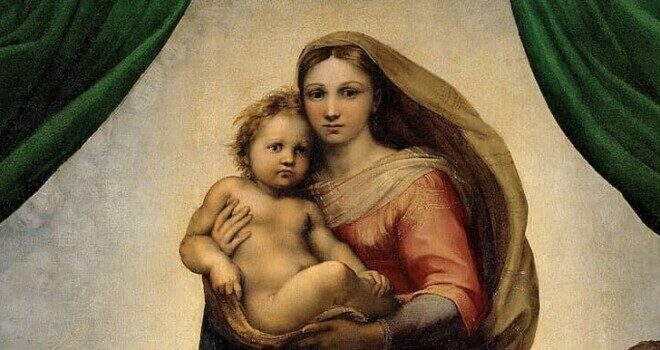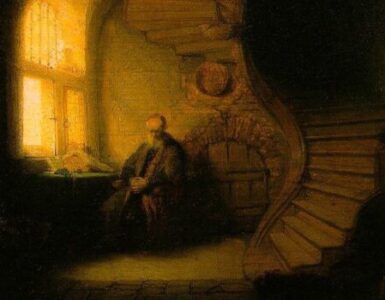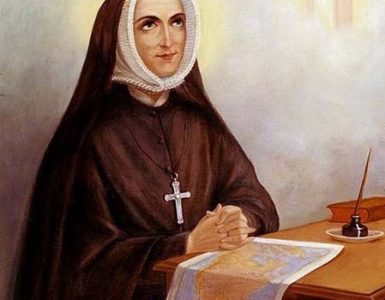There is no other human being who lives in closer union with God than Our Blessed Mother. Her heart, mind, body, and soul are perfectly ordered to Him. Her soul is completely receptive to the workings of God. She ponders all things in her heart before she acts. She penetrates the mysteries of God through deep prayer. In this receptivity and life of deep prayer she was set ablaze with the burning love of the Most Holy Trinity. Her interior prayer life is a model for eucharistic revival because she shows us how to enter into intimate union with Her Son.
The first Pentecost came through the overshadowing of the Holy Spirit over Mary at the Annunciation. Her heart was set ablaze by the fire of the love of the Trinity when her spouse the Holy Spirit came over her for Christ to be conceived in Her womb. When she prayed with the Apostles and the women in the Upper Room, she had already received the Holy Spirit. She was interceding and guiding her spiritual children, the nascent Church, at Pentecost. She continues to intercede and lead us to union with the Most Holy Trinity today. She will lead us to eucharistic revival.
Her life on earth was one of constant prayer in the Spirit. “She pondered all these things in her heart” (Luke 2:19). Whenever the mysteries of God unfolded around her, she always brought them to prayer. Her expansive soul welcomed the workings of the Most Holy Trinity. She never grasped at anything. She lived a life of total receptivity, which then allowed her to give away all she received to others.
The nine months while Our Lord and Savior dwelt within her womb made her a living tabernacle. She constantly adored and contemplated the profound mystery of the Lord dwelling within her. She sought deeper and deeper union with God. As Fr. Gabriel of St. Mary Magdalene writes in Divine Intimacy:
Our Blessed Mother reveals to us that true glory and grandeur are found within, where we live in intimate communion with the Most Holy Trinity. This intimate unity can only be found in prayer. The Holy Spirit leads us ever deeper into the mystery of God, but we must live in a disposition of openness and receptivity. We cannot grasp at God or the things of this world. We must give our yes to God through a willingness to wage the very difficult battle that is daily prayer. We must seek to open our souls more to Him through a relinquishment of self and the things of this world. This means that we must abandon our own plans for His and make deep prayer a priority each day.
The Church today is being hampered in her mission because we have abandoned this interior disposition of Mary. The world is not transformed by our projects, committees, and plans. It will only be transformed by a Church that is living the interiority of Mary. The Church, as the feminine counterpart to the masculine Head, Who is Christ, is meant to live in intimacy with Christ, which is the fruit of prayer alone.
It is in prayer that we become receptive to Him and His workings within us. Prayer holds primacy in the Christian life. Firstly, through the Mass and the other Sacraments, but then through a life of deep meditation, openness to the gift of contemplation, and a willingness to allow the Holy Spirit to transform our hearts into raging infernos of God’s love. It is only through a deep interior life that we can be sent forth to lead others to Christ. Apostolate must be born of prayer, including eucharistic revival.
This interiority is essential for the Church’s desire to bring about eucharistic revival. There will be no revival without a return to prayer and the interior life. Decades of activism and social justice have rotted away at the Church’s witness. It has created an environment where it is difficult for Christians to enter into intimacy with Christ in the Blessed Sacrament. We cannot truly receive Our Lord in the Blessed Sacrament in a loving way unless we are people of interior prayer. It is in the school of prayer that our hearts are opened more fully to His indwelling in the Holy Eucharist.
Our Blessed Mother is our example for how to enter into deeper union with Christ in the Holy Eucharist. She was a living tabernacle as she carried Christ in her womb, but also when she received Him at every Mass. Fr. Gabriel describes Our Blessed Mother’s experience of the love of God, which she gained through pondering and praying in union with Christ in her womb:
Mary was the first “living ciborium” who adored the Incarnate Word of God. She lived a life of interior prayer, which united her fully to Christ. All members of Christ’s Church become “living ciboriums” whenever we receive Our Lord in the Holy Eucharist. The Lord comes to dwell within us in order to ignite a “burning furnace of charity” in our hearts. The Blessed Sacrament is the Sacrament of Charity.
Interior union with Christ in the Blessed Sacrament is nearly impossible if we are not a people of interior prayer. If we are not actively seeking intimacy with the Most Holy Trinity we will be unable to enter into the mystery dwelling within us whenever we receive Christ in the Holy Eucharist. Our distractions, sins, weaknesses, and temptations lead us to place walls around our hearts and minds. Prayer is where the Lord breaks down these walls. It is this breakdown in prayer and the interior life that has paved the way for such widespread disbelief in the Real Presence of Jesus in the Holy Eucharist.
A busy people is a people who cannot become recollected. Without this recollection, there is very little intimacy with God and very little transformation in our lives. We will not be inflamed with the love of God, as Our Blessed Mother was on earth and is in heaven. We live as ‘clamoring gongs’ because we have not received the fullness of the burning love Christ wants to give to each one of us.
The only way there will be eucharistic revival is if we “ponder all of these mysteries” within our hearts like Our Blessed Mother. There will be no revival if we do not return to a life of deep prayer and intimacy with the Most Holy Trinity. Our plans are useless without interior lives of transforming prayer. Our plans are useless if they are not God’s plans. We only come to know His plans through lives of deep interior prayer.
Our Blessed Mother shows us how we are each called to live the interior life. If we open ourselves to the workings of the Most Holy Trinity as she did while here on earth, then we will experience hearts set ablaze with the burning love of God. It is through this interior burning love that we will be able to go out into a broken world to bring souls to Christ. To be a truly eucharistic people, we must live Marian interiority and ponder all of these things in our hearts. Only then will we experience the indwelling of the Incarnate Word of God every Holy Eucharist we receive.
Raphael. (1514). Sistine Madonna. [painting]. Retrieved from RaphaelPaintings.org.












